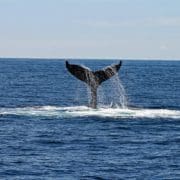Humpback Whale Facts
Humpback Whale Facts
Learn more about Humpback Whale Facts with Australia Whale Experience. Humpback whales get their name from the visible hump that forms in front of their short dorsal fin. This dorsal fin is short and stubby when compared to the fins of dolphins and other whales. This hump is highlighted when they are getting ready to dive, rise, and flex their backs.
A typical humpback whale has a pale belly, dark back, and pleats on its neck. Megaptera novaeangliae or “Big-winged New Englander” is the scientific name given to this species, since it was well known to Europeans who swam in the waters around New England.
Size
Humpback whales can reach a length of 15 to 19 metres (roughly the length of a school bus) and a weight of 40 tonnes. Their large and unwieldy flippers (pectoral fins) are among their most notable and distinguishing characteristics. They have the largest pectoral fins of any baleen whale, measuring over 5 metres long.
Behaviour
Typically, humpbacks migrate in small groups of two to three whales, known as pods, rather than travelling in large numbers. Mom and baby whales even touch their fins as a likely gesture of affection while they are travelling together. Occasionally, they even assist each other in hunting or finding food.
A humpback whale’s typical route between its nesting and feeding areas can be as far as 3,000 miles (5,000 km). Among the longest migrations ever documented was a journey that spanned an incredible 11,706 miles (18,840 km) between American Samoa and the Antarctic Peninsula.
Whale Songs
These whales are recognised for their eerie, evocative cries or songs. The patterns of groans, screams, cries, and other sounds are extremely intricate, and they can last for several hours. Scientists are trying to figure out what these noises represent.
Humpback whales sing to converse with one another and to attract possible mates, according to several experts. There have been reports of humpback calves “whispering” to their mothers. This might help them in avoiding predators and large males.
Conservation Status
The humpback whale population in the western South Atlantic has been reduced to approximately 450 individuals as a result of decades of intensive whaling industry hunting. Since the 1985 moratorium on commercial whaling, however, humpback whale populations have rebounded in a number of locations. Humpback whales face the greatest dangers now from ship crashes and fishing gear entanglements.
Conclusion
Humpback whales are truly magnificent creatures that exhibit complex behaviours. They are found in every ocean on earth and are recognized for their incredible acrobatic ability when it comes to breaching the water.
Browse Our Photo Gallery



